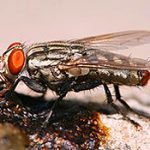Flesh-fly maggots occasionally eat other larvae although this is usually because the other larvae are smaller and get in the way. Flesh-flies and their larvae are also known to eat decaying vegetable matter and excrement and they may be found around compost piles and pit latrines.
Flesh-flies, being viviparous, frequently give birth to live young on corpses of animals, at any stage of decomposition from recently dead through to bloated or decaying (though the latter is more common).
The life cycle of flesh-fly larvae has been well researched and is very predictable. Different species prefer bodies in different states of decomposition, and the specific preferences and predictable life cycle timings allows forensic entomologists to understand the progress of decomposition and enables the calculation of the time of death by back extrapolation. This is done by determining the oldest larva of each species present, measuring the ambient temperature and from these values, calculating the earliest possible date and time for deposition of larvae. This yields an approximate time and date of death (d.o.d.) This evidence can be used in forensic entomology investigations and may assist in identification of a corpse by matching the calculated time of death with reports of missing persons. Such evidence has also been used to help identify murderers.
Flesh-flies can carry leprosy bacilli and can transmit intestinal pseudomyiasis to people who eat the flesh-fly larvae. Flesh-flies, particularly Wohlfahrtia magnifica, can also cause myiasis in animals, mostly to sheep, and can give them blood poisoning, or asymptomatic leprosy infections.

